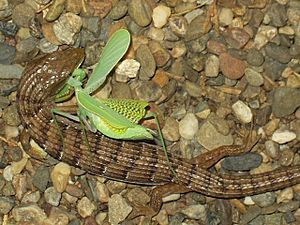Insectivore facts for kids

An insectivore is an animal or insect that mostly eats insects. Think of it like a special diet! These creatures get almost all their food and energy from munching on bugs.
It's not always easy to be an insectivore. Insects are small, so a large animal needs to eat many of them to get enough food. For example, a giant anteater can eat thousands of ants and termites every single day!
Some omnivores, like humans and bears, also eat insects sometimes. But for true insectivores, insects are their main meal. Even some plants are insectivores, like the amazing Venus fly-trap!
Contents
What is an Insectivore?
An insectivore is any living thing that gets its food mainly from insects. This includes many different kinds of animals, from tiny spiders to large mammals. It also includes some plants that have special ways to catch bugs.
Animals That Eat Insects
Many animals are insectivores. Here are a few examples:
- Anteaters: These animals are famous for eating ants and termites. They have long, sticky tongues to slurp up their meals.
- Shrews: These are small, mouse-like mammals. They have very fast metabolisms and need to eat almost constantly. Insects are a perfect quick meal for them.
- Bats: Many types of bats are insectivores. They use echolocation (like sonar) to find flying insects in the dark.
- Spiders: Almost all spiders are insectivores. They spin webs or hunt to catch insects.
- Birds: Many birds, especially smaller ones, eat insects. Think of swallows catching flies in the air.
- Frogs and Lizards: Most frogs and many lizards are insectivores. They use their quick tongues to snatch bugs.
Plants That Eat Insects
Yes, some plants eat insects! These are called carnivorous plants. They usually live in places where the soil doesn't have enough nutrients. Eating insects helps them get the extra food they need.
- Venus Flytrap: This plant has leaves that look like a mouth. When an insect touches tiny hairs inside, the trap snaps shut!
- Pitcher Plants: These plants have deep, slippery cups filled with liquid. Insects fall in and can't get out.
- Sundews: These plants have sticky hairs on their leaves. Insects get stuck to the hairs, and then the plant slowly digests them.
Why Eat Insects?
Insects are a great source of protein and other nutrients. They are also very common, so there's usually a lot of them around. However, because insects are small, insectivores often have to eat a huge number of them to get enough energy. This is why many insectivores have special adaptations, like long tongues, sticky saliva, or super-fast reflexes, to catch their tiny prey.
Related Eating Habits
Animals can have different diets. Here are some other ways animals get their food:
- Herbivores: These animals eat mostly plants. Think of cows eating grass or rabbits munching on carrots.
- Carnivores: These animals eat mostly meat from other animals. Lions hunting zebras are a good example.
- Detritivores: These animals eat dead plants, dead animals, or other decaying matter. They help clean up the environment. Earthworms are detritivores.
- Omnivores: These animals eat both plants and animals. Humans are omnivores, as are bears and raccoons.
Images for kids
-
This aardwolf skull shows small molars and carnassials. These teeth are not needed for eating soft insects like termites. The aardwolf uses its canine teeth for self-defence and digging.
-
A robber fly eating a hoverfly.
-
The giant anteater, a large mammal that eats insects.
See also
 In Spanish: Insectívoro para niños
In Spanish: Insectívoro para niños





